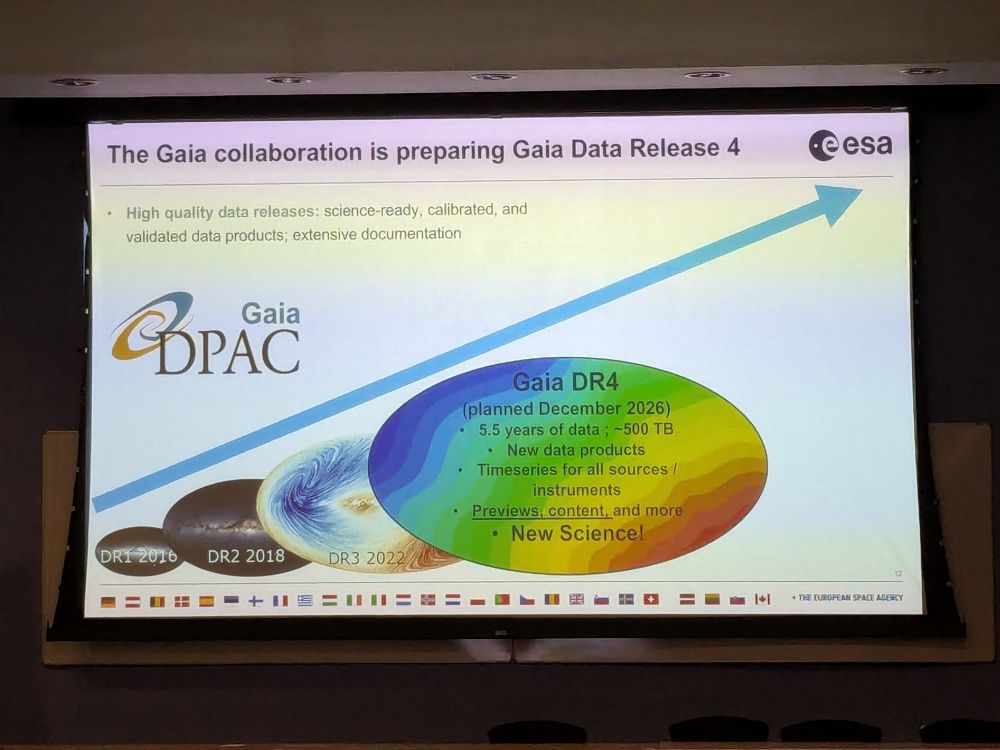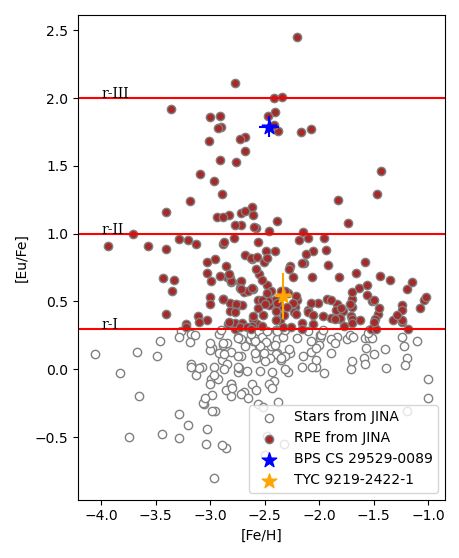Just a reminder, the Wide-Field Spectroscopic Telescope is a project to build a 12m telescope fully dedicated to multi-object spectroscopy. It will have a large FoV (>3 deg^2) and combine high‐multiplex spectrographs of both low‐ and high‐resolution and a giant panoramic integral field spectrograph
24.10.2025 13:19 — 👍 0 🔁 0 💬 1 📌 0

📣 The second issue of the WST Chronicle is out!
www.dropbox.com/scl/fi/zmd3m...
📄 The WST Chronicle is an electronic magazine designed to keep the WST science teams and the broader scientific community updated on the latest developments of the project
🔭 ☄️ #stellarastro #galactic #instrumentation
24.10.2025 13:19 — 👍 2 🔁 1 💬 2 📌 0

⚠️ "Krytyczna sytuacja finansowa CAMK PAN: Instytut naukowy płaci za błędy państwa sprzed dekad
www.camk.edu.pl/pl/archiwum/...
#Nauka #Polska
09.10.2025 08:23 — 👍 0 🔁 0 💬 0 📌 0
Oooh the Nobel Prize is out today, so it's time for my yearly round of ignoring that news and reading about many of the women who were snubbed of the prize in the past and who the Nobel Prize committee refuses to apologise for. 🧪🔭
07.10.2025 13:15 — 👍 194 🔁 44 💬 7 📌 1

how to win a nobel physics prize 🔭✨☄️
07.10.2025 15:03 — 👍 49 🔁 17 💬 3 📌 2
The work was funded by a grant from the Polish National Science Centre (NCN) @ncn.gov.pl
03.10.2025 08:54 — 👍 0 🔁 0 💬 0 📌 0
🧑🤝🧑 We calibrated a similarity metric that can identify stars with parameters that differ by ± 200 K, ± 0.3 dex, and ± 0.2 dex in effective temperatures, surface gravities, and metallicities, respectively. We achieved completeness between 74-98 % and typical purity between 39-54 % in this selection
03.10.2025 08:54 — 👍 0 🔁 0 💬 1 📌 0
⌨️ In this paper, we present a procedure for the identification of stars with similar atmospheric parameters, before any radiative transfer analysis is performed
We used projection maps created by the t-SNE dimensionality reduction algorithm applied directly to the spectra using pixels as dimensions
03.10.2025 08:54 — 👍 0 🔁 0 💬 1 📌 0
♟️CHESS stands for the CHEmical Survey analysis System, a pipeline that aims to provide precise and accurate atmospheric parameters and abundances for large samples of FGK-type stars
⭐ For that, we use multiple instances of differential analysis done against samples of reference stars
03.10.2025 08:54 — 👍 0 🔁 0 💬 1 📌 0

🔭 New paper of the @sagateam.bsky.social accepted in A&A!
This is the first paper of the upcoming "Playing CHESS with stars" series!
The paper was lead by John Martínez Fernández and Sergen Özdemir, Ph.D. students at the SAGA Team
arxiv.org/abs/2509.19443
#stellarastro #SagaTeamCAMK
03.10.2025 08:54 — 👍 3 🔁 0 💬 1 📌 0

The High-Resolution Multi-Object Spectrograph (HRMOS) has a new webpage:
www.hrmos.eu
HRMOS will be proposed as a new instrument for the Very Large Telescope of ESO as part of the VLT2030 roadmap
It will combine very high-resolution (80k), >50 multiplex, and high RV precision
#instrumentation 🔭
14.08.2025 13:03 — 👍 5 🔁 2 💬 0 📌 0
Congrats to the CUBES consortium!
07.08.2025 13:34 — 👍 0 🔁 0 💬 0 📌 0

Getting an account on the RSP
Before getting started: Understand whether you have Rubin data rights.- Rubin data rights are required in order to hold an account in the Rubin Science Platform., All scientists and students affili...
🔭 Friendly advice for astronomers in the US and Chile--if you are excited to access @vrubinobs.bsky.social Data Preview 1 on Monday, request your account *now*--it has to get approved by a human. For best results use your university single-sign on, if available.
rsp.lsst.io/guides/getti...
27.06.2025 00:06 — 👍 26 🔁 15 💬 0 📌 0

A photo of the slide with the December 2026 release date
Finding out about Gaia at #EAS2025Cork! ☄️
Just announced: Gaia DR4 will be released in December 2026!
26.06.2025 14:11 — 👍 96 🔁 37 💬 1 📌 1
Oh, and teaser: We have plans to release high level spectra like HASP but for each unique COS and STIS target ever observed by #Hubble since STIS started operating in 1997 🔭🧪
25.06.2025 17:02 — 👍 15 🔁 2 💬 0 📌 0
🇪🇺 Members of the #SAGATeamCAMK are involved in the working group responsible for the exoplanet, stellar, and Galactic science case. The WST project is funded by the European Union under Grant ID 101183153 awarded within the HORIZON-INFRA-2024-DEV-01 call (cordis.europa.eu/project/id/1...)
24.06.2025 16:06 — 👍 0 🔁 0 💬 0 📌 0
👩🏫 This first issue of the WST Chronicle includes descriptions of the WST consortium and its organisation, an overview of the science drivers and the top‐level requirements, and a presentation of the project timeline, among other information
24.06.2025 16:06 — 👍 0 🔁 0 💬 1 📌 0
🤯 The Wide-Field Spectroscopic Telescope is a project to build a 12m telescope fully dedicated to multi-object spectroscopy. It will have a large FoV (>3 deg^2) and combine high‐multiplex spectrographs of both low‐ and high‐resolution and a giant panoramic integral field spectrograph
24.06.2025 16:06 — 👍 0 🔁 0 💬 1 📌 0

🔭 ☄️ #stellarastro #galactic #instrumentation
🤩First issue of the WST Chronicle
www.wstelescope.com/wst-chronicle
📰 The WST Chronicle is an electronic magazine designed to keep the WST science teams and the broader scientific community updated on the latest developments of the project
24.06.2025 16:06 — 👍 15 🔁 2 💬 1 📌 0
🔭 ☄️ #stellarastro
24.06.2025 15:59 — 👍 5 🔁 0 💬 0 📌 0
The attached figure shows how our two stars compare to other known metal-poor stars that are rich in neutron capture elements (showing in particular, the chemical element europium).
14.03.2025 18:06 — 👍 0 🔁 0 💬 0 📌 0
👨🏫 Finally, we also found that the chemical abundances in the two stars seem consistent with expectations for stars enriched by a single population III core collapse supernova. If true, this would make the two stars part of the second generation of stars being formed in the Universe.
14.03.2025 18:06 — 👍 0 🔁 0 💬 1 📌 0
🚀 The other star, called TYC 9219-2422-1, is part of the Galactic halo and was formed outside the Milky Way, in the dwarf galaxy that merged with the Milky Way some 9 billion years ago and is now called the Gaia-Enceladus merger event.
14.03.2025 18:06 — 👍 0 🔁 0 💬 1 📌 0
👵 We found that the star called BPS CS 29529-0089 was formed in proto-disk of the Milky Way, the structure that was just starting to form the disk of our Galaxy some 12 billion years ago.
14.03.2025 18:06 — 👍 0 🔁 0 💬 1 📌 0
🛠💻 In this work, we investigated in detail the properties of two old metal-poor stars. We determined abundances of 27 neutron-capture elements for them. We also investigated their orbits in the Galaxy and tried to understand the origin of these stars.
14.03.2025 18:06 — 👍 0 🔁 0 💬 1 📌 0
💥 In these processes, the atoms are gradually capturing several neutrons until at a later time some of the additional neutrons decay and transform into protons. When this happens, the atom becomes a new, heavier, chemical element.
14.03.2025 18:06 — 👍 0 🔁 0 💬 1 📌 0
⭐️ The bottom half of the periodic table, containing the elements heavier than Fe, cannot be produced by normal nuclear burning inside stars. They are produced by what astronomers call "neutron-capture processes".
14.03.2025 18:06 — 👍 0 🔁 0 💬 1 📌 0
👨🎓 The paper is led by André Rodrigo da Silva, member of the SAGA Team, Ph.D. student of the GeoPlanet Doctoral School working at the Centrum Astronomiczne im. M. Kopernika PAN
This work was funded by an OPUS grant of @ncn.gov.pl
14.03.2025 18:06 — 👍 0 🔁 0 💬 1 📌 0

🚨New paper alert! 🔭☄️🧪
📄 The paper entitled: "Discovery of a pair of very metal-poor stars enriched in neutron-capture elements: The proto-disk r-II star BPS CS 29529-0089 and the Gaia-Sausage-Enceladus r-I star TYC 9219-2422-1" was accepted for publication in A&A
See:
arxiv.org/abs/2503.04926
14.03.2025 18:06 — 👍 7 🔁 1 💬 1 📌 0
📚 Raising awareness of academic abuse
🤝 Support | Resources | Advocacy
🌐 Main Site: academicabuse.com
🚀 Support My Work: go.academicabuse.com
Working Group on Star Names (WGSN) of the International Astronomical Union (IAU). Maintained by @susanne-m-hoffmann.bsky.social @msfa94.bsky.social
Official Account of the EAS Annual Meeting #EAS2025Cork
The US NGO at NSF NOIRLab supports Gemini Observatory
users in the stages of the astronomical observing cycle, from proposal to data reduction. Visit our website at https://noirlab.edu/science/programs/csdc/usngo.
Keeping you posted on space science activities from the European Space Agency.
Web: http://www.esa.int/science
Privacy Notice: esa.int/connectwithus
#astronomy #space #science
We boost UK prosperity, understand the Universe, and protect our planet and outer space. gov.uk/ukspaceagency.
Institute of Cosmos Sciences of the University of Barcelona (ICCUB)
Outreach at @ICCUBdivulga.bsky.social
Member of SOMM Alliance
#50YearsOfESA: we're the European Space Agency, keeping you posted on European space activities.
Please see our Privacy Notice: https://esa.int/connectwithus
Cutting-edge research, news, commentary, and visuals from the Science family of journals. https://www.science.org
Researcher at Max Planck institute for solar system research.
Studying solar activity and variability.
I am not on x (twitter), my account there is deleted.
https://scholar.google.com/citations?user=8gnK6BsAAAAJ&hl=en
Dad, husband, astrophysicist, dog herder. Samuel T. and Fern Yanagisawa Regents Professor in Astronomy at UT Austin. This is a personal account and the views expressed in my posts here are mine. https://mrbk.github.io
Science communicator: Passionate about science, family, endless forms most beautiful...and Swiss chocolate. Author of WOMEN IN SCIENCE NOW (https://amazon.com/Women-Science-Now-Strategies-Achieving/dp/0231206143) via
@columbiaup.bsky.social
Trying to leave things better than I find them
Analytical Scientist 👩🔬 #AcademicMentalHealth advocate 🌱 Founder VoicesofAcademia.com 💬 Author of "Managing Your Mental Health During Your PhD" 📘 ADHDer 💚 Proud mum 👶 she/her. Views mine.
Assyriologist at Wolfson College (Oxford), writer plagued by self-doubt, lover of dead languages. I think we should all be doing what we can to save the planet.
My book is now out! 😎 https://lnk.to/BetweenTwoRivers
Official account for Monthly Notices of the Royal Astronomical Society (MNRAS), Geophysical Journal International (GJI) and RAS Techniques and Instruments (RASTI). See also https://academic.oup.com/rasjournals
Astrophysicist | Associate Professor & UKRI FLF at the Institute for Computational Cosmology, Durham | Interested in: galaxies; dynamics; bars; dark matter; science4peace; cats; (not necessarily in that order) | Cypriot #κυπραία #kıbrıslı
Cosmologist & Galactic Archaeologist at
@Sydney_Uni. Proud Silurian, Australian immigrant, & author of books about the strange universe we find ourselves in!
PhD candidate/NSF Fellow @UHIfA/@CenterForAstro ❀ astrochemist ✿ @astrobites author 𑁍 chemical & biomolecular eng/astrophysics @UCBerkeley ✾ @AAS_SC ❁ my views
Soon: Ultra metal-poor stars at Uppsala University! Current: Stellar analysis pipelines for PLATO and 4MOST. Former Astrobites author. GM, cellist, fiber crafter. More people should care about CMB spectral distortions.









